A RARE MAMLUK KNIFE WITH RICHLY DECORATED SCABBARD Mamluk Sultanate, 14th - 16th century. Overall length 21.5 cm, blade 11 cm. Blade of finely watered steel decorated with three embedded coral beads and the inscription "The time of the reign of Sultan Malik Zahir"; on the reverse "Fly high, bird of distress and revenge, your rigor and fairness affirm human fate". Square tapered handle of blue glass. Ivory scabbard is richly inlaid with mother of pearl, brass and stones, representing the heavens, with gilt bronze fittings with garnets and turquoise.
We found 389642 price guide item(s) matching your search
There are 389642 lots that match your search criteria. Subscribe now to get instant access to the full price guide service.
Click here to subscribe- List
- Grid
-
389642 item(s)/page
A BRONZE STANDING FIGURE OF GUANYIN "China, Tang dynasty (618-906 AD). Height 10.5 cm. The slender figure swaying gently and with long ribbons flowing around the body, the head crowned with a headdress, the right hand held beside the body and holding a length of drapery and the left hand raised to the shoulder and holding a pot, all standing on a high double-lotus pedestal. Provenance: Collection of a Czech sinologist, purchased in Beijing in the early 1950s.
A BRONZE FIGURE OF GUANYIN "China, Tang Dynasty (618-906 AD). Height 12.5 cm. The standing figure of the bodhisattva shown with right hand raised and holding a willow branch while dangling a small vase from the lowered left hand, the hair worn in long tresses and drawn up into a topknot behind the ribbon-tied fillet, all standing on a lotus pedestal. Provenance: Collection of a Czech sinologist, purchased in Beijing in the early 1950s.
ÉCOLE AUTRICHIENNE (XIXe-XXe siècle) GUERRIER SUR SON TAPIS DE PRIÈRE WARRIOR PRAYING Bronze de Vienne patine polychrome représentant un guerrier agenouillé, les mains implorant sur un tapis. Son livre de prière, son bâton et ses babouches posées autour de lui. (Petits manques à la polychromie). Haut. 13 cm- Larg. 12,5 cm - Long. 16 cm (Dim. 5.5 x 5 x 6.5 in.)
BERGMAN (éCOLE AUTRICHIENNE XIXe-XXe siècle) - LES JOUEURS DE DéS - LES MUSICIENS THE DICE PLAYERS MUSICIANS Deux épreuves en bronze polychrome, représentant l’un un groupe de trois enfants jouant aux dés, et l’autre un groupe d’enfants musiciens sur un tapis frangé. Marqués "B" sous le tapis. Haut : 3 cm Larg : 7,5 cm Long 5,5 cm (Dim 1.2 x 3 x 2.2 in.)
FERNANDEZ ARMAN (1928-2005) LUTH HOMMAGE A OUM KALSOUM OUM KALSOUM LUTH Sculpture composée de deux éléments. Un élément en bronze argenté dans lequel est inclu un luth découpé en marqueterie, accompagné d’un luth en marqueterie de nacre. Œuvre originale à 8 exemplaires, et 4 épreuves d’artiste. Signée et numérotée sur le socle. Haut 87 cm (HEIGHT.34 in.)
ÉCOLE ORIENTALISTE (début du XIXE siècle) CAVALIER GREC À PIED GREEK HORSEMAN ON FOOT Fonte d`édition ancienne en étain patiné et bronze doré, à contre-socle à décor de rinceaux et cuirs découpés et socle rectangulaire à pans coupés en marbre noir. Mention "Brevet" estampée sur la base. (Un étrier manquant et un pied du socle à refixer). Philhellénisme, vers 1900. HAUT. 28,5 cm (Height 11 IN.)
NéCESSAIRE DE CALLIGRAPHIE OTTOMAN comprenant : une écritoire portative (divit) en bronze à décor ciselé du sceau de Salomon et de l`arbre de vie ; une paire de ciseaux (kakma) damasquinée d`or et d`argent ; un petit couteau (kalamtras) à manche en corail et ivoire incrusté de petits cabochons de turquoise et de nacre ; un repose-plume (maqta) en écaille de tortue ; un polissoir en coquillage (muhre) sculpté du verset du Coran (61, 13 : nasr min Allah wa fath qarib) ; un polissoir à manche en ivoire et embout en argent et aventurine. Turquie, XIXe siècle. A 19th century ottoman set of utensils for a scribe.
A collection of four cold cast bronze figurines of American Indians, three of which are by Buck McCain and one by Jim Porter; all come with Franklin Mint certificates of authenticity. The subjects are: "Prayer to the Healing Spirit" with horse-rider holding skull; "Indian Hunter", warrior with bow and arrow; Indian with mountain lion holding a tomahawk aloft and "Soaring Spirit", Indian with eagles, all provided with wooden dishes (certificates held in reception).Heights from 34.5 to 54cm
* Cartier, Santos, a midi two colour wristwatch, circa 1994, ref. 65718, no. 187901, the two piece screwed case with bronze effect dial, raised Roman numerals, blued steel hands and date aperture, 6 jewel Cartier quartz movement, cal. 87, the case 42mm including lugs, on a block link bracelet with fold over clasp, in a Cartier box with guarantee and booklet
Edward Delaney RHA (1930-2009) WARRIOR, c.1960s bronze 17.5 by 7 by 6in., 43.75 by 17.5 by 15cm. P Warrior is a typical mid-career bronze by Edward Delaney. Inspired by Irish mythology, and in particular the heroics of Cúchulainn, the sculpture is a highly modernist work which captures Delaney`s pursuit of a pure sculptural expression in the shape of a surreal and almost abstract figure. This is what the art historian Dr Róisín Kennedy described, in her essay on the artist for his 2004 RHA retrospective, as the sculptor`s persistent search for the vital form". Warrior was first exhibited at a one man exhibition in the Building Centre, Baggot Street in 1960 and at a further exhibition in the David Hendriks gallery in 1966. It has since been included in many group shows and exhibitions."
George Barry Laffan (1918-1988) HEAD OF A WOMAN limestone 15.75 by 10.5 by 7.5in., 39.375 by 26.25 by 18.75cm. P Family of the artist;Thence by descent Born in Australia to Irish parents George Laffan returned to the family home in Rathmines, Dublin at the age of 15. He attended the National College of Art, Dublin from 1939-1945 at night where he studied under Laurence Campbell RHA (1911-1964). He exhibited with the RHA from 1943 to 1945 and at the Oireachtas in 1948. The human figure was his main focus but he diversified in his choice of materials, experimenting with wax, clay, bronze, stone, wood and plaster. As a painter he concentrated on portraits by commission and of family members, as well as landscapes and still lifes. Examples of woodcuts by Laffan also exist. His work was included in the Institute of the Sculptors of Ireland exhibitions in 1955 and 1956. In the 1960s the female form in various guises and poses dominated. In 1972, The Kenny Gallery in Galway hosted a group show which included Laffan and his son, Justin, John Behan and Stepinac McNamee. The same year he exhibited at the IELA, where the Times commented on his highly competent ballerinas" which had a "flavour of the old-fashioned salon about them". Laffan was treasurer with Independent Artists and exhibited with them in Trinity College, Dublin in 1973 and Project Arts Centre, 1975. Heads - executed in a variety of materials - became the artist`s focus for a ten year period from 1974-1984. He showed at the Oireachtas in 1978 a 2.4m high bog oak piece called Maighdean Dubh. In 1984 he retuned to Australia where he made landscape and portrait sketches. Female torsos in bog oak and walnut feature in his final years. He died in Dublin in 1988 aged 70. "
George Barry Laffan (1918-1988) PETER" [KING GEORGE VI]" wood 17 by 8.5 by 7in., 42.5 by 21.25 by 17.5cm. P Family of the artist;Thence by descent RHA, Dublin, 1943, catalogue no. 357 as Peter [£33-0-0] Born in Australia to Irish parents George Laffan returned to the family home in Rathmines, Dublin at the age of 15. He attended the National College of Art, Dublin from 1939-1945 at night where he studied under Laurence Campbell RHA (1911-1964). He exhibited with the RHA from 1943 to 1945 and at the Oireachtas in 1948. The human figure was his main focus but he diversified in his choice of materials, experimenting with wax, clay, bronze, stone, wood and plaster. As a painter he concentrated on portraits by commission and of family members, as well as landscapes and still lifes. Examples of woodcuts by Laffan also exist. His work was included in the Institute of the Sculptors of Ireland exhibitions in 1955 and 1956. In the 1960s the female form in various guises and poses dominated. In 1972, The Kenny Gallery in Galway hosted a group show which included Laffan and his son, Justin, John Behan and Stepinac McNamee. The same year he exhibited at the IELA, where the Times commented on his highly competent ballerinas" which had a "flavour of the old-fashioned salon about them". Laffan was treasurer with Independent Artists and exhibited with them in Trinity College, Dublin in 1973 and Project Arts Centre, 1975. Heads - executed in a variety of materials - became the artist`s focus for a ten year period from 1974-1984. He showed at the Oireachtas in 1978 a 2.4m high bog oak piece called Maighdean Dubh. In 1984 he retuned to Australia where he made landscape and portrait sketches. Female torsos in bog oak and walnut feature in his final years. He died in Dublin in 1988 aged 70. "
-
389642 item(s)/page







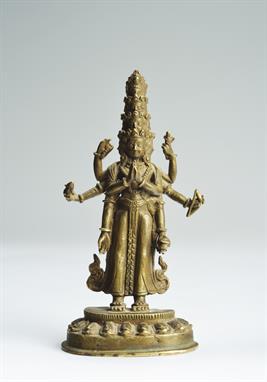















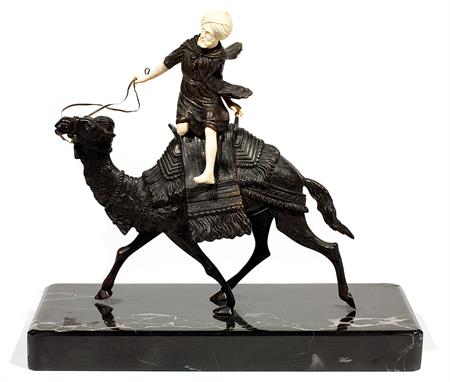

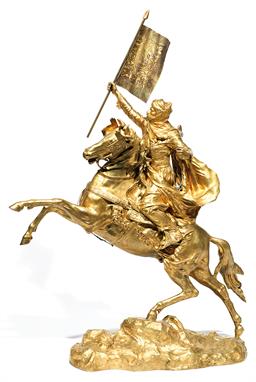
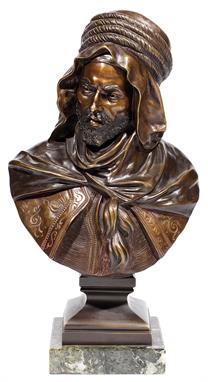




























![John Behan RHA (b.1938) WOMAN WITH SHORT HAIR bronze on black marble base indistinctly signed and numbered; bears number [33]](http://lot-images.atgmedia.com/SR/10092/2891191/113-2013114195140_468x382.jpg)
![John Behan RHA (b.1938) HEAD OF A WOMAN bronze on black marble base indistinctly signed and numbered; bears number [34] on la](http://lot-images.atgmedia.com/SR/10092/2891191/114-2013114195142_468x382.jpg)
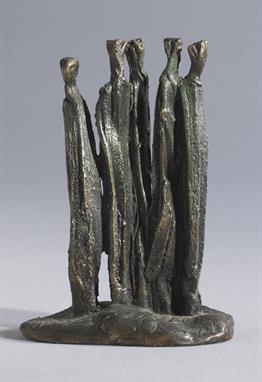


![George Barry Laffan (1918-1988) PETER" [KING GEORGE VI]" wood 17 by 8.5 by 7in., 42.5 by 21.25 by 17.5cm. P Family](http://lot-images.atgmedia.com/SR/10092/2891191/121-2013114195149_468x382.jpg)